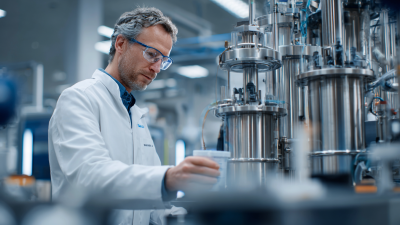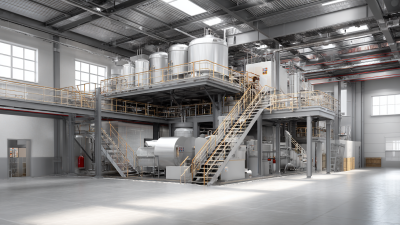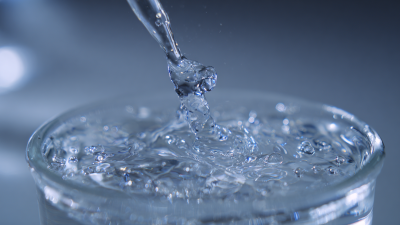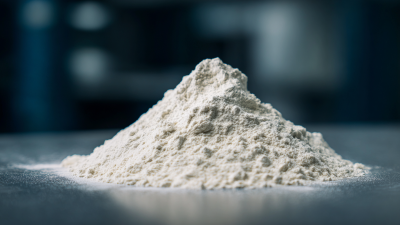Understanding the Role of Hpmc Manufacturer in Modern Construction Materials
Table of Contents
- The Importance of HPMC in Enhancing Construction Material Performance
- Key Properties of HPMC That Benefit Modern Construction Applications
- How HPMC Manufacturers Ensure Quality and Consistency in Production
- Innovative Uses of HPMC in Sustainable Construction Practices
- Tips for Selecting the Right HPMC Supplier for Your Project
- Future Trends in HPMC Development for the Construction Industry
- Exploring HPMC LK80M: The Key to Superior Thickening in Modern Construction Materials - Insights from Industry Reports
- FAQS
- Conclusion
- Related Posts
You know, in the ever-changing world of construction, the role that HPMC manufacturers play has become more and more important—especially as the demand for top-notch building materials keeps climbing. I came across this report from Mordor Intelligence that predicts the global market for construction chemicals could hit around a trillion dollars by 2026. A lot of that growth is thanks to additive producers like Longou International Business (Shanghai) Co., Ltd. They’re really making waves as a top provider of construction chemicals and solutions.

Longou’s all about bringing innovative materials to the table—things that boost how durable and eco-friendly modern buildings can be. One key product they focus on is Hydroxypropyl Methylcellulose, or HPMC. It doesn’t just help improve workability and adhesion of the materials—it's also a step toward greener building practices.
With so many HPMC manufacturers out there shaping high-quality, reliable construction solutions, Longou definitely has an important role in meeting the rising global need for efficient building materials that you can trust.
The Importance of HPMC in Enhancing Construction Material Performance
 Hydroxypropyl methylcellulose, or HPMC for short, really plays a key role in boosting the performance of modern construction materials. Basically, it's a water-soluble polymer that's super versatile—used a lot in cement mixes to make things easier to work with and to help stuff stick better. One of its coolest features is that it helps retain water in the mix, which is actually pretty important for making sure the structures last and stay durable over time. By stopping the water from evaporating too quickly during curing, HPMC helps create stronger, more resilient buildings.
Hydroxypropyl methylcellulose, or HPMC for short, really plays a key role in boosting the performance of modern construction materials. Basically, it's a water-soluble polymer that's super versatile—used a lot in cement mixes to make things easier to work with and to help stuff stick better. One of its coolest features is that it helps retain water in the mix, which is actually pretty important for making sure the structures last and stay durable over time. By stopping the water from evaporating too quickly during curing, HPMC helps create stronger, more resilient buildings.
But that’s not all—HPMC is also a big help when it comes to making construction products like tile adhesives, plasters, and grouts more consistent and stable. Its ability to tweak viscosity means these materials stay put better—they don’t sag or slump as much when you’re applying them. That’s a real win for contractors because it makes the application way easier and results in a smoother, more even finish. As new construction techniques keep coming up, using HPMC in formulations is becoming more and more essential for meeting the growing demands of efficiency and performance in building stuff that lasts.
Key Properties of HPMC That Benefit Modern Construction Applications
Hydroxypropyl Methylcellulose, or HPMC for short, is pretty important in modern construction materials. You've probably seen it in things like adhesives, plaster, and mortar because it really boosts performance. One of the coolest things about HPMC is its ability to hold onto water. This means it helps your mixtures stay workable longer and stops them from drying out too quickly—especially handy on big construction projects where keeping everything hydrated just right is key to getting that solid, strong finish. Industry reports say that adding HPMC can jolt up adhesion strength by as much as 30%, which really helps make structures last longer and stay more durable.
But it’s not just about water retention. HPMC also makes your mixes flow better and more evenly. That helps prevent gaps or flaws that could weaken the structure later on. As construction keeps moving toward more high-tech and demanding projects, we’re seeing more folks turn to materials like HPMC that can handle the challenges. In fact, the global market for HPMC in building is expected to grow a lot—mainly because everyone’s looking for more efficient, sustainable ways to build.
When you’re choosing HPMC for your project, a little tip—think about what you really need. Different grades have different viscosity levels, and some are better suited for high-performance mortars because they shear-thin nicely. It's always a good idea to check out the technical datasheets to make sure everything plays nicely together with your other materials. Trust me, a bit of prep goes a long way!
Key Properties of HPMC in Modern Construction Applications
This chart illustrates the key properties of Hydroxypropyl Methylcellulose (HPMC) that significantly benefit modern construction applications, highlighting their importance in enhancing material performance.
How HPMC Manufacturers Ensure Quality and Consistency in Production
Hydroxypropyl methylcellulose (HPMC) manufacturers definitely play a pretty important role when it comes to modern construction materials. They’re the folks behind producing this really versatile cellulose ether, which is used as a key additive in all sorts of stuff—think tile adhesives, wall putty, and cement mixes. Honestly, the quality and how well these materials perform really rely on the properties of HPMC, so the manufacturer’s work is absolutely central to making sure everything in a construction project holds up well and is reliable.
To keep the quality consistent, HPMC companies stick to strict quality control measures throughout the whole process. They make sure to source high-purity raw materials and use advanced tech for synthesis and modifications. By running thorough testing on each batch—checking things like viscosity, solubility, and gelation—they can be pretty confident that the product will perform perfectly in construction jobs. Plus, these manufacturers are always working on improving their processes and coming up with new ideas, which helps them respond quickly to what the market needs. At the end of the day, this means clients get a product that doesn’t just meet expectations but often exceeds them.
Innovative Uses of HPMC in Sustainable Construction Practices
Lately, Hydroxypropyl Methylcellulose (HPMC) has really started to make a splash as a key additive in modern building materials, especially when it comes to sustainable construction. As the industry aims to shrink its environmental impact, incorporating HPMC offers some pretty exciting options. I came across a report from Research and Markets that says the global HPMC market is expected to grow by about 5.7% each year – mostly because it works so well in things like tile adhesives, plaster, and paints that are eco-friendly.
Longou International Business (Shanghai) Co., Ltd. is actually leading the charge in this space, offering innovative construction chemicals tailored for customers worldwide. HPMC doesn’t just boost how well things stick together and how easy they are to work with; it also helps with water retention, which is super important for energy-efficient buildings. It’s all part of the bigger picture — more builders are looking for green materials that save energy and cut down on waste.
**Pro tip:** When you’re choosing HPMC for your projects, go for those designed for high-performance use—that way, your structures will be more durable and last longer. And if you’re mixing mortar, using HPMC can make it more flexible and help prevent cracking, which is pretty great for keeping things sustainable in the long run.
Tips for Selecting the Right HPMC Supplier for Your Project
When you're trying to pick the right HPMC (Hydroxypropyl Methylcellulose) supplier for your construction project, it’s really important to check out their reputation in the industry. Honestly, look for manufacturers who’ve got a solid track record of delivering high-quality products on time. Taking some time to read customer reviews or case studies can give you a pretty good idea of how reliable they are and what you can expect. And don’t forget—see if they can provide certifications or test results to back up their claims. That way, you’re making sure you go with a supplier that truly cares about quality.

Another thing to consider is how good their technical support and customer service are. A supplier that offers thorough guidance—whether it’s about choosing the right product, application tips, or how to use HPMC in construction—can really make a difference in your project's success. It helps if they have a knowledgeable team that can help troubleshoot formulation problems or come up with custom solutions tailored to what you need. Building a good relationship with your HPMC supplier isn’t just smart; it can actually make your entire project run smoother and boost the overall quality of your materials.
Future Trends in HPMC Development for the Construction Industry
The development of Hydroxypropyl Methylcellulose (HPMC) really matters for today’s construction materials because it helps improve how well they work and how versatile they are. Lately, there’s been a noticeable shift toward making HPMC in a more sustainable and eco-friendly way. Companies are increasingly trying to follow green chemistry practices, aiming to cut down on waste and shrink their carbon footprint during the production process. It’s part of a bigger move in the industry towards greener habits, which is attracting more and more environmentally conscious builders and consumers alike.
Another pretty exciting trend is customizing HPMC derivatives to fit different construction needs. Thanks to advancements in polymer science, manufacturers can now tweak formulations to boost things like water retention, adhesion, and flexibility. As construction techniques keep evolving, there’s definitely going to be a bigger push for high-performance materials that work smoothly with newer tech, like self-healing concrete and 3D printing. All in all, HPMC producers are in a great position to come up with innovative solutions that make modern building projects more durable and efficient — pretty cool, right?
Exploring HPMC LK80M: The Key to Superior Thickening in Modern Construction Materials - Insights from Industry Reports
Exploring HPMC LK80M: The Key to Superior Thickening in Modern Construction Materials
In the realm of modern construction materials, the importance of effective thickening agents cannot be overstated. One such standout product is MODCELL ® HPMC LK80M, a hydroxypropyl methyl cellulose (HPMC) renowned for its superior thickening and gelling abilities. Derived from naturally purified cotton cellulose, this non-ionic cellulose ether boasts remarkable water solubility and retention, crucial for maintaining the integrity of construction mixtures. Industry reports indicate that the use of HPMC in construction applications leads to improved workability and durability of materials, as it enhances the viscosity and prevents segregation in cement-based products.
The unique properties of MODCELL ® HPMC LK80M extend beyond mere thickening; it offers exceptional performance in a wide range of conditions. Its stable pH value and surface activity contribute to effective cement film formation and lubrication, making it an indispensable additive in both building and repair applications. Moreover, the versatility of this HPMC variant is underscored by its mold resistance and thermal stability, which have been highlighted in various studies. As construction continues to evolve, incorporating innovative additives such as MODCELL ® HPMC LK80M not only optimizes performance but also aligns with the industry's growing demand for sustainable and reliable solutions.
All these factors contribute to the increasing recognition of HPMC LK80M among industry professionals. With its extensive application range spanning construction, pharmaceuticals, food, and cosmetics, MODCELL ® HPMC LK80M stands out as a reliable ingredient that ensures quality and performance across various sectors. In fact, reports suggest that the global market for cellulose ethers is expected to grow significantly, further solidifying HPMC's pivotal role in modern formulations.
FAQS
: HPMC is used as an additive in various construction materials, enhancing the performance of applications such as adhesives, plaster, and mortar.
HPMC improves water retention, which extends workability and prevents rapid drying, crucial for maintaining optimal hydration conditions in large-scale projects.
Incorporating HPMC can improve adhesion strength by up to 30%, contributing significantly to the durability and longevity of structures.
Improved flow characteristics of HPMC ensure uniform distribution, reducing the risk of voids and imperfections that can compromise structural integrity.
Manufacturers adhere to stringent quality control measures including sourcing high-purity raw materials, deploying advanced technologies, and implementing rigorous testing protocols.
Consider the supplier’s reputation, quality of products, reliable delivery times, ability to provide certifications, and the level of technical support and customer service they offer.
The global market for HPMC in construction is projected to grow significantly due to the increasing demand for efficiency and sustainability in building practices.
Higher viscosity grades may offer better shear-thinning characteristics, making them more suitable for high-performance mortars.
Continuous improvements and innovations in production techniques allow manufacturers to effectively respond to market demands and guarantee high-quality products.
Technical support from suppliers can significantly enhance project outcomes by providing guidance on product selection, application techniques, and customized solutions.
Conclusion
You know, in the ever-changing world of modern construction materials, the importance of HPMC (that’s Hydroxypropyl Methylcellulose) manufacturers is really growing. I mean, HPMC plays a big role in boosting the performance of building materials—it makes them more workable, helps retain water, and improves how well they stick together. What’s pretty cool is how versatile it is, compatible with all kinds of formulations, and eco-friendly too. That’s why, these days, it’s pretty much a must-have in sustainable construction projects.
To keep up with demand and ensure top-notch quality, HPMC producers are pretty strict with their quality controls and are always coming up with innovative ways to produce it. As the construction industry faces new challenges, the trend seems to be leaning more towards sustainability and advanced applications for HPMC. When choosing a supplier, like Longou International Business (Shanghai) Co., Ltd.—which is known for delivering high-quality materials—you set yourself up for a smoother project and better results all around.
Related Posts
-

7 Essential Tips for Understanding Hpmc Density in Your Industry
-

Understanding Hpmc Use in Modern Manufacturing Processes
-

How to Choose the Right Cellulose Ether Factory for Your Business Needs
-

7 Essential Tips for Understanding Hydroxyethyl Cellulose Solubility in Water
-

Exploring Opportunities in Redispersible Polymer Powder at the 2025 China Import and Export Fair
-

Unlocking the Potential of Methyl Cellulose Polymer in Your Supply Chain
Blog Tags:






